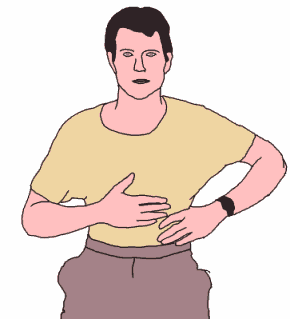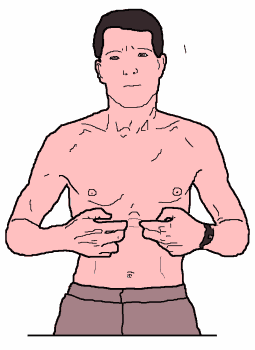|
|
|---|
Breathing Experiments, Start Position:-
- Sit in a high backed kitchen or office chair with your buttock well back in the seat and
the lean back so that your back is fully supported.
- Think "spine lengthen upward".
- Place your left hand over the left side of your rib cage - thumb touching the ribs at the back,
and index finger touching ribs at the front.
- Place your right hand over your solar plexus.
- Now try two different styles of breathing!
(1) Chair Sitter's Breathing- Action:-
- Breathe slowly and deeply. Relax - do not hyperventilate!
- Which parts move as you breathe? - Your abdomen? - Perhaps the front of your chest?
(2) Pilates Breathing (Back & Sides Breathing):-
- Gently zip and hollow your lower abdomen. (refer "Zip and Hollow" and "Zip, Fine Control").
- Breathe slowly and deeply, through your nose and stay relaxed - again, do not hyperventilate!
- Which parts move as you breathe now? Your upper abdomen? The sides of your chest?
Possibly also the ribs at the back of your chest are now also moving?
(pilates breathing exercises, scroll right>>>>)
|
|
|
(3) Pilates Breathing Technique: Wringing the breathe out:-
Place your fingers as in the lower two diagrams. This will alow you to monitor the movement of your ribs just
below the sternum. Take a deep breathe in, and note the expansion between your fingers.
Now breathe out, and note the decreased gap between your fingers. Pause and wring the breathe out by closing
the gap between your fingers further, and after another pause, do it again!
Why do Pilates Style Breathing?:-
Pilates himself had asthma as a child, and he adapted this style of breathing from yoga(7,8).
Back and sides breathing is also recommended by Alexander Teachers(6).
Simple enough to teach as breathing exercises for both children and seniors with asthma.
|



|
It also promotes spinal stability. See following discussion, also page 26.
|
|
Pilates Breathing Stabilizes your Lumbar Spine.
Refer back to your experience when you tried "Chair Sitter's Breathing".
When you breathed in, you noticed that your rib cage tilted so as to
"look upward" and that your mid spine (the middle of your back) arched.
Can you understand how a deep breath can push your middle spine outside
of its strong middle range, & how Pilates breathing can stop that? -
Here are examples:-
(1) Pilates Breathing brings Control and Poise
to Professional Singers:-
At an amateur singing competition, contestants were reminded not to move
shoulders and arms while breathing in - You wouldn't see Pavarotti doing that,
nor would you see Pilates do it!
(2) Pilates Breathing brings Control and Stability to those who Run:-
20 years ago I trained hard for a half marathon. I never made it.
I developed mid and lower back pain with sensory loss to the side of my foot -
signs of L5-S1 disc protrusion. For many years after that, my mid lumbar spine felt
vulnerable if I took deep breaths during running. Pilates breathing fixed that - I
don't feel vulnerable nowadays.
Reference:-
- The Official Body Control Pilates Manual Available from: http://www.bodycontrol.co.uk/
- Wilfred Barlow: "The Alexander Principle" Arrow Books Ltd. Reprinted 1987 ISBN 0 09 910160 2
-
ABC of Yoga.com: Advanced Breathing Techniques
-
Biography of Joseph Pilates
© Bruce Thomson EasyVigour Project scroll up^^^....
|


